Necessity is the mother of invention, as is the case for what has long been the defining Japanese sport-utility vehicle in its class. In its early, formative years, despite not being the first on the scene, the Honda CR-V had the field pretty much to itself – though utilitarian and workman-like rather than sophisticated, the first two generations of the RD worked as well as they did because the market for such vehicles had yet to mature, and competition in the arena was scarce.
Things looked even prettier when the third-gen RE appeared a decade ago – the car arrived at a time when the demand for SUVs had well kicked in, and it wasn’t a surprise to see adoption rates for it being high. The competition may have started to shape, but the CR-V had also grown up. Far more refined and dynamically involving than its predecessors, the third outing more than held its own against contenders throughout its market life.
The fourth-gen RM attempted to replicate that. For a while, the going was good, but momentum was faltering – the model arrived here late, as shown by its short four-year cycle, and competition had begun to stiffen. Evolution more than the revolution the third one had been, the CR-V’s superiority had completely waned by the time the RM’s life-cycle ended, its position as market leader stripped.
The debut of the fifth-gen a few months ago is very much targeted at re-establishing that supremacy – necessity of invention has brought about turbocharging, a raft of new, class-leading driver-assist tech and plenty of features. The RW has stamped its mark early on in taking back the mantle, as reflected through its bookings, but just how good is the latest iteration of the ‘Comfortable Runabout Vehicle’? We find out by taking it on a drive to Johor and back.
Though it’s fast becoming a common sight on the road, a quick look at the exterior – at 4,584 mm long, 1,855 mm wide and 1,679 mm tall (1,689 mm for the 4WD version), the fifth-gen is slightly longer (fourth-gen, 4,545 mm, +39 mm) and wider (1,820 mm, +35 mm) than its predecessor, though it sits lower (1,685 mm, -6 mm).
While the size and general shape doesn’t veer far from the previous model, the new CR-V has a far more imposing visual presence, its bold front end and edgier lines helping to scale up the SUV in more prominent fashion. It’s still unmistakably CR-V though, with a side profile largely reminiscent of the RM.
In line with the sportier looks, 18-inch alloy wheels (with 235/60 profile tyres) find their way on, these common to all the turbo variants, while the solitary normally-aspirated version rides on 17-inch units (with 235/65 series rubbers). It’s a matter of preference, but the latter’s design works better, the 18-inch being a bit too busy-looking, at least to my eyes.
The new interior is an advancement over the fourth-gen‘s, not so much in terms of design but in material choices and presentation. Cues to the lack of finesse in the older car’s cabin was already evident when we first sampled it in 2013, but as pointed out then, the car was designed during the economic downturn towards the end of the last decade, and pretty much outfitted as a result of that inadvertent switch to austerity.
Time has only amplified this, and the short of it is that the years haven’t been kind to the previous CR-V’s interior – I took out a demonstrator from Honda Malaysia prior to the drive to re-establish a baseline for comparison, and was struck by how poorly the materials have held up. It could in its earlier form. The resident third-gen RE is seven years old, and yet the materials in its cabin continue to offer better resolution, all the while holding up to wear far better than the fourth-gen’s.
That on the new car brings things back to an even keel. Materials are good to the touch and sight, and on the whole the interior presentation in the new CR-V has plenty of coherency, especially with the dashboard layout.
The new full-colour LCD TFT instrument cluster has plenty of visual appeal, and legibility levels are good. The centre console is also better resolved, especially at the top end – the seven-inch central display tidies up the fascia considerably, and the AC controls and area around the gearshift are far better resolved compared to that on the old car.
It’s not all roses though. Arguably, the second-gen KF Mazda CX-5‘s interior feels plusher, and for overall cabin presentation everything in the class available here must surely bow to the seminal Peugeot 3008. Elsewhere, in isolation, there are some elements that are bound to invite polarity of opinion.
One of these is with the choice of faux-wood trim accents for the door cards, dashboard and sides of the centre console. Its inclusion may be to introduce a more luxurious feel, but you get the feeling that the chosen shade won’t be to everyone’s tastes. I’m not particularly big on it, but there are stronger opinions, like that from Hafriz Shah, who says it resembles ‘Javanese furniture from the ‘90s’.
The other half isn’t a fan either. She popped in to the showroom to have a look at the CR-V following the launch, and promptly asked the sales person if there was any way she could get a 1.5L Turbo with the silver accent trim from the 2.0 NA. I guess you can’t please them all.
Aside from that, the car pretty much scored pluses right through with the lady during the brief walk-around, the biggest one being the volume offered by the centre console storage bin. While still referencing the third-gen’s void space between the centre console and fascia as being a perfect location for handbag and shoe stowage, the ability to secure a bag within the confines of the console in the new car seems to have softened that firm stance.
Ergonomics-wise, the CR-V’s cabin is class leading for space, with plenty of storage solutions. As for the seats, even if they’re not the most snug offerings in the segment, the front units offer good support and comfort, and hold up well over long haul runs.
The back row, meanwhile, is an outright winner in terms of legroom and spatial presence, easily ahead of the rest of the field in the class. Aided by all this acreage, the comfort levels at the back of the five-seater are high – with three to a vehicle on the drive, there was plenty of opportunity to get familiar with the rear seats.
The drive saw two of the three available 1.5L Turbo models being trialled – the assembled mules consisted of Premium 2WD units with Honda Sensing as well as a couple of turbo 4WD variants.
To recap, the 1.5L Turbo variants are equipped with a 1.5 litre direct injection turbocharged VTEC engine offering 193 PS and 243 Nm of torque from 2,000 to 5,000 rpm, while the sole normally-aspirated 2.0L i-VTEC 2WD is powered by the existing 2.0 litre R20 motor, which has 155 PS and 190 Nm. All the CR-V variants feature a Honda’s Earth Dreams CVT transmission, which takes over from the five-speed auto.
We had previously tried the CR-V in June ahead of its market debut in July, but that was on a closed, short course event meant to highlight the workings of the Honda Sensing suite of safety technologies. With time limited to that offered during the demonstration, there was little to take away in terms of any real observations about the SUV.
The road test provided all the necessary answers. As you’d expect, the new turbo mill provides plenty of poke. Coming in from the rather lumpy R20, the difference in take-up across the entire speed spectrum is pronounced, and even though the turbo’s delivery is tuned for progression than immediacy, the new car unsurprisingly leaves the 2.0 litre well for dead.
As noted during the Sensing trail in June, the turbo is also pacier off the line than the old 2.4 litre, and its delivery aspects are intrinsically smoother. The CVT, meanwhile, is a decent replacement for the ageing five-speeder – it’s responsive, and behaviour-wise has an automatic feel to it, with very little rubber banding evident. There’s a trace of associated CVT whine though, which takes some edge off the shine.
With development benchmarked against the Volkswagen Tiguan, gains in areas such as dynamics and stability, steering precision/feedback as well as vehicle response to input have come about, all aimed at bringing the SUV well back into the game. With regards to steering precision, the report card on that scores full marks – aside from having better weight and feel, it has also addressed an issue bugging previous gen models.
This concerns the need to continuously perform micro adjustments of the steering to maintain line composure at highway running speeds, especially tiring over a long haul. Prominent on the third-gen, and still noticeable on the fourth (as a run down to Seremban with the recent loaner showed), I’d always thought it was something that I was just being overly sensitive about ever since we bought the RE back in 2010, but colleague Danny Tan had also picked up on this during our 2011 five SUV shootout.
That irregularity is now completely absent on the fifth-gen, and the improved steering accuracy and corresponding straight-line fidelity is nothing short of sterling. Curious about this, I brought the matter up with Honda R&D assistant chief engineer Syoji Takahashi, the chassis project leader for the CR-V, who was present at the drive. He said efforts to improve the ride and handling also involved correcting the tetchy steering behaviour, something the engineers were aware of.
As for gains in ride and handling over the fourth-gen, the differences aren’t huge, but they are still noticeable. Ride, though still veering to the soft side, isn’t mushy, and the primary is competent over all but the most demanding surfaces. Handling-wise, there’s less body roll, and the new CR-V’s response to input is also faster and sharper than before.
It still isn’t quite CX-5 territory, however, as shown from a session involving a short loop over marginally winding terrain to trial vehicle dynamics. Meant to compare the new CR-V against the fourth-gen model, Honda Malaysia also added a couple of the CR-V’s competitors, the T32 Nissan X-Trail and CX-5 (in its first-gen KE guise) into the mix, both in their 2.5 litre forms.
While notably ahead of the X-Trail and fourth-gen in composure and balance, the new CR-V didn’t quite get the measure of the CX-5 in areas such as dynamics and body control, its reaction to load switching being much softer. The difference isn’t dramatic, but the Mazda offers a better viewpoint from a driver’s perspective. In terms of overall pace and response across the course, however, the turbo’d Honda simply aced the field.
The 4WD doesn’t feel as urgent as the 2WD, as reflected by its slower century sprint time of 9.2 seconds to the latter’s 8.8 seconds. Interestingly though, it behaved much better in its standard drive mode rather than in Sport, as opposed to the 2WD – it simply felt less fluid and free-spirited in Sport when pushed, something the co-drivers in the car also observed.
Speaking of Sport mode, the map bumps up the revs on the 1.5 litre turbo mill by around 500 rpm in-gear, but you’ll have to remember to switch off the Econ mode button to get any action.
It also presented a slightly different ride perspective – Takahashi confirmed that while the suspension layout and geometry remains the same for both the 2WD and 4WD, the rear absorbers on the 4WD have a different tune to cope with the additional weight of the variant (1,595 kg, which is 46 kg more than the 2WD with Sensing). The tune results in both secondary and primary ride being firmer, but I actually preferred its depiction, in particular the better planted primary outlook at high speeds.
With regards to NVH levels, the new CR-V is much quieter than its predecessor, but still lagging behind in absolute terms compared to say, Continental offerings (the Peugeot 3008, for one) as speeds climb. The new CX-5 is also ahead on this count, apparently – having sampled both SUVs recently, Hafriz reports that the second-gen Mazda offers a higher level of NVH isolation.
Prior to the drive, there was also a quick demonstration to compare the advancements made in the new car’s Real Time 4WD system, pitching it against the previous-gen’s in an exercise involving a short left/right fast transition course.
Offering improved traction and control, the system is now lighter and is able to provide 10% more torque to the rear wheels, and over the test the new CR-V demonstrated superior levels of grip and predictability, its tracking composure much tauter – and truer – than that of the previous-gen.
Finally, notes about a few of the Honda Sensing features (detailed earlier in our first impressions of it) from a road-going perspective, these being of Lane Keeping Assist System (LKAS), Adaptive Cruise Control (ACC) and the Low Speed Follow (LSF) function.
Employing the suite’s monocular camera (positioned between the windshield and rear-view mirror, with a 24.5 degree field of vision) and millimetre wave radar, which has an operating range of around 100 metres (long range, 10 degree angle; short range, 42 degree angle), ACC was sampled heavily throughout the drive – the system worked flawlessly, even in heavy rain (a pleasant surprise), maintaining specified distances set for it.
This was provided that surrounding traffic played nice. A number of late lane changes from other vehicles placed them in the CR-V’s immediate path – most times, the Sensing system caught this and deployed autonomous braking (some in rather hard fashion), but driver intervention for braking was needed on a couple of occasions. High marks for the vehicle’s braking system, since we’re on that thread.
The same can be said about the LSF, which performed as intended, although as you can imagine it’s not particularly ideal in heavy traffic conditions – the four metre stopping distance between cars saw enough vehicles happily slipping in front of the CR-V that we stopped employing it during traffic crawls if we were on the right-most lane.
By and large though, there’s no arguing that the Sensing suite is a great thing to have, with the system providing a layer of safety in unobtrusive fashion. A large number of buyers seem to agree – last month, it was reported that 40% of CR-V orders have been for the 1.5L Turbo Premium 2WD variant.
An impressive turbo mill, Honda Sensing and exceptional interior space are but only a few of the things making a strong argument for the fifth-gen Honda CR-V. Add in a features and kit count list – right from the baseline variant – that is peerless, and it’s all good enough to ensure that the Honda is a compelling proposition for buyers in the price segment, one that’s truly greater than the sum of its parts. Indeed, from an all-round perspective, it’s simply unbeatable. Welcome then – again – the once and future king.
Check out the full specifications of the 2017 Honda CR-V and compare all the variants at CarBase.my.
Looking to sell your car? Sell it with Carro.

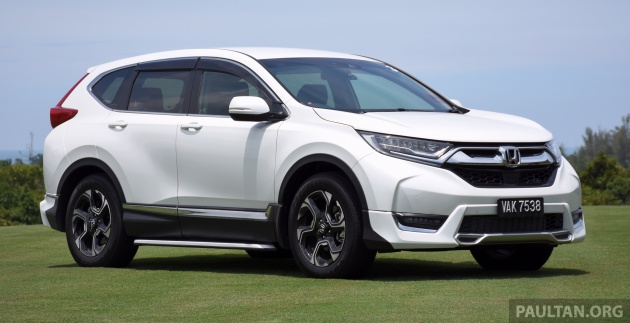
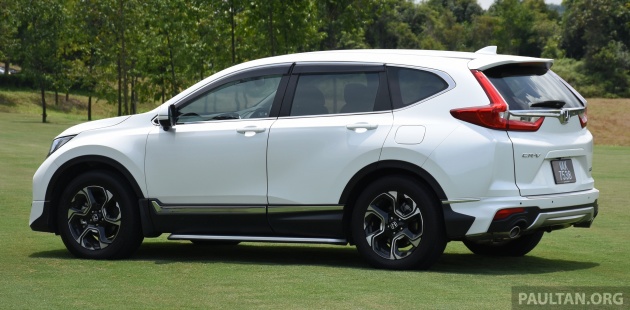




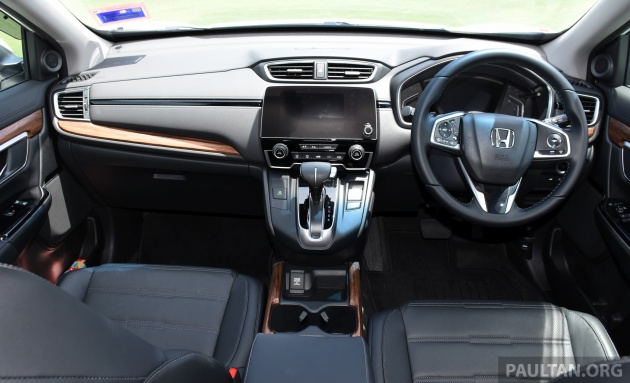
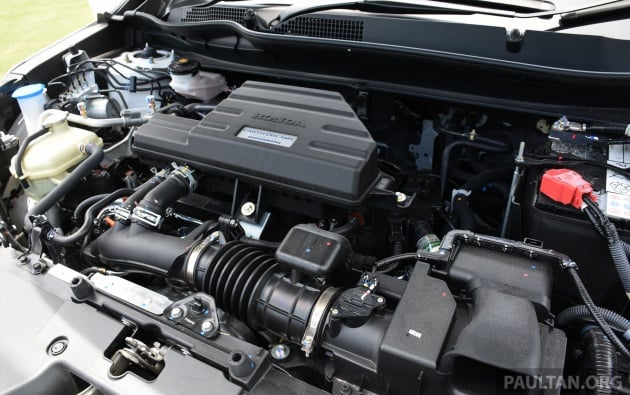






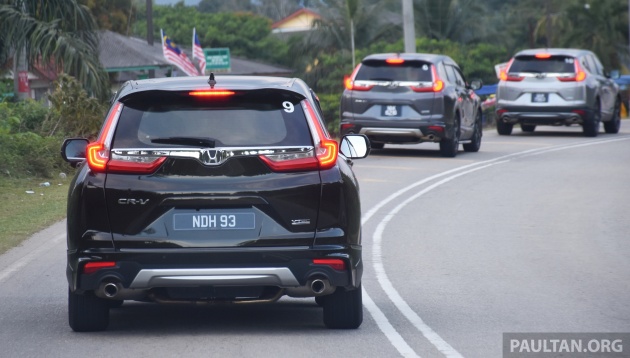
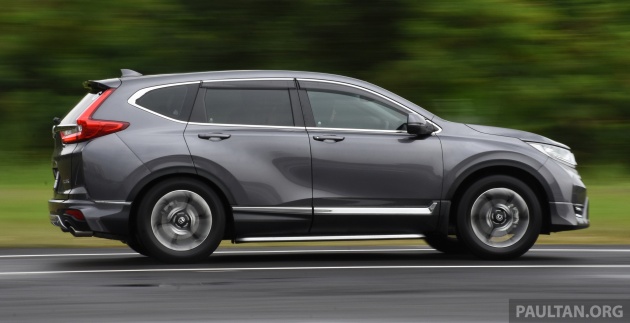

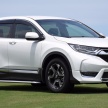
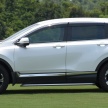



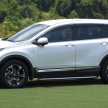
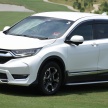
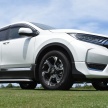
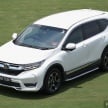

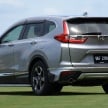

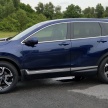
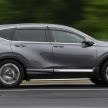
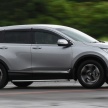

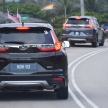
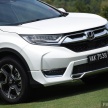
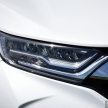



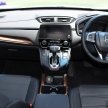


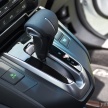

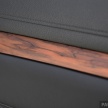

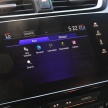
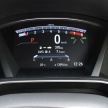
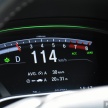
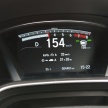
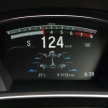
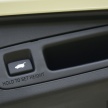
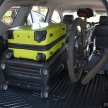
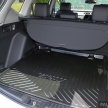
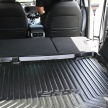
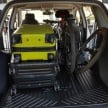



















AI-generated Summary ✨
Comments generally express admiration for the Honda CR-V’s top performance, space, and exterior design, reinforcing its status as a class leader. Many users appreciate its spacious interior, handling, and modern look, but are disappointed by the lack of features like adaptive cruise control, GPS, hands-free tailgate, and blind spot monitoring in the Malaysian version compared to international models. Several comments criticize Honda Malaysia for removed or unavailable features, which many perceive as a cost-cutting move driven by local taxes rather than customer demand. Service experiences and aftersales are also criticized, with some users feeling Honda’s offerings do not match their expectations based on global standards. Overall, there’s strong positive sentiment about the car’s qualities but notable frustration over missing features and perceived value.